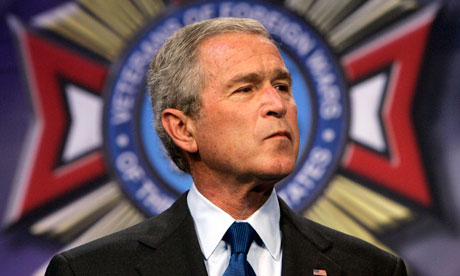A secret campaign of surveillance, sabotage, cyberattacks and assassinations has slowed but not stopped Tehran's programme

Iran's nuclear ambitions led then US
president George W Bush to launch a covert war in 2007 to thwart the
programme. Photograph: Jim Young/REUTERS
The covert war on Iran's
nuclear programme was launched in earnest by George Bush in 2007. It is
a fair assumption that the western powers had been trying their best to
spy on the Islamic Republic since the 1979 Iranian revolution, but the
2007 "presidential finding" put those efforts on a new footing.
Bush asked Congress to approve $400m for a programme of support for rebel ethnic groups, as well as intelligence gathering and sabotage of the nuclear programme. Part of that effort involved slipping defective parts such as centrifuge components into the black market supply to Iran, designed to blow apart while in operation and in so doing bring down all the centrifuges in the vicinity. The UK, Germany, France and Israel are said to have been involved in similar efforts. Meanwhile, western intelligence agencies stepped up their attempt to infiltrate the programme, seeking to recruit Iranian scientists when they travelled abroad.
That espionage effort appears to have paid dividends. In 2009, the US, British and French intelligence agencies were able to confirm that extensive excavations at Fordow, a Revolutionary Guard base near the Shia theological centre of Qom, were a secret uranium enrichment plant under construction. The digging had been seen by satellites, but only human sources could identify its purpose. Barack Obama, Gordon Brown and Nicolas Sarkozy were able to reveal Fordow's existence at the UN general assembly in September 2009, a diplomatic setback to Iran. Russia, which had been Iran's principal protector on the world stage, was furious with Tehran at having been taken by surprise.
It is harder to gauge the impact of sabotage. Olli Heinonen, the former chief inspector of the International Atomic Energy Agency, said: "I never saw any direct evidence of sabotage. We could see that they had breakages but it was hard to say if those were the result of their own technical problems or sabotage. I suspect a little of both."
Gholam Reza Aghazadeh, the head of Iran's atomic energy organisation, complained to the press in 2006 about sabotage but vowed that Iran would overcome the challenge by making more of the centrifuges and other components itself.
But it was impossible to make everything at home. The computer systems which run the centrifuge operations in Natanz, supplied by the German engineering firm Siemens, were targeted last year by a computer worm called Stuxnet, reportedly created as a joint venture by US and Israeli intelligence. President Mahmoud Ahmadinejad conceded that Stuxnet had caused damage, and last November, Iranian scientists were forced to suspend enrichment to rectify the problem. A few days later, however, the centrifuges were working once more.
The black operations have not been confined to hardware and computer systems. They have also targeted Iran's scientists. In July 2009, an Iranian nuclear expert called Shahram Amiri vanished while on a pilgrimage to Mecca. A year later, he surfaced in the US claiming he had been abducted by American agents, and in July 2010 he returned to a hero's welcome in Tehran.
US officials said he had been a willing defector who had been paid $5m for his help, but who had since had a mysterious change of heart. There have since been claims Amiri had been an Iranian double agent all along. The truth is unclear.
Other attempts to remove Iran's scientists have been blunter and bloodier.
Starting in January 2010, there were a series of attacks in Tehran on Iranian physicists with links to the nuclear programme. The first target was Masoud Ali Mohammadi, a physicist and lecturer at the Imam Hussein university, run by the Revolutionary Guards. He was on his way to work when a bomb fixed to a motorbike parked outside his house exploded and killed him instantly.
In November that year, assassins on motorbikes targeted two Iranian scientists simultaneously as they were stuck in morning traffic. In both cases, the killers drove up alongside their targets' cars and stuck bombs to the side. Majid Shahriari, a scientist at the atomic energy organisation, who had co-authored a paper on neutron diffusion in a nuclear reactor, was killed.
The other target, Fereidoun Abbasi-Davani, suspected by western officials of being a central figure in experiments on building a nuclear warhead, was only injured. Three months later he was promoted to the leadership of the nuclear programme.
A third scientist, Darioush Rezaeinejad, was killed in an attack in July this year, when gunmen on motorbikes shot him in a street in east Tehran. He was initially described in the Iranian media as a "nuclear scientist", but the government later denied he had any involvement in the programme.
Iran has blamed the attacks on the Israeli secret service, Mossad, and in August sentenced an Iranian, Majid Jamali-Fashi, to death for his alleged involvement in the Ali Mohammadi killing. He had confessed to being part of a hit-team trained in Israel, but it appeared likely he had made the confession under torture.
Despite the millions spent, stalled machines and deaths of leading scientists, Iran has steadily built up its stockpile of enriched uranium to 4.5 tonnes – enough for four nuclear bombs if it was further refined to weapons-grade purity. At most, the covert war has slowed the rate of progress, but it has not stopped it.
Bush asked Congress to approve $400m for a programme of support for rebel ethnic groups, as well as intelligence gathering and sabotage of the nuclear programme. Part of that effort involved slipping defective parts such as centrifuge components into the black market supply to Iran, designed to blow apart while in operation and in so doing bring down all the centrifuges in the vicinity. The UK, Germany, France and Israel are said to have been involved in similar efforts. Meanwhile, western intelligence agencies stepped up their attempt to infiltrate the programme, seeking to recruit Iranian scientists when they travelled abroad.
That espionage effort appears to have paid dividends. In 2009, the US, British and French intelligence agencies were able to confirm that extensive excavations at Fordow, a Revolutionary Guard base near the Shia theological centre of Qom, were a secret uranium enrichment plant under construction. The digging had been seen by satellites, but only human sources could identify its purpose. Barack Obama, Gordon Brown and Nicolas Sarkozy were able to reveal Fordow's existence at the UN general assembly in September 2009, a diplomatic setback to Iran. Russia, which had been Iran's principal protector on the world stage, was furious with Tehran at having been taken by surprise.
It is harder to gauge the impact of sabotage. Olli Heinonen, the former chief inspector of the International Atomic Energy Agency, said: "I never saw any direct evidence of sabotage. We could see that they had breakages but it was hard to say if those were the result of their own technical problems or sabotage. I suspect a little of both."
Gholam Reza Aghazadeh, the head of Iran's atomic energy organisation, complained to the press in 2006 about sabotage but vowed that Iran would overcome the challenge by making more of the centrifuges and other components itself.
But it was impossible to make everything at home. The computer systems which run the centrifuge operations in Natanz, supplied by the German engineering firm Siemens, were targeted last year by a computer worm called Stuxnet, reportedly created as a joint venture by US and Israeli intelligence. President Mahmoud Ahmadinejad conceded that Stuxnet had caused damage, and last November, Iranian scientists were forced to suspend enrichment to rectify the problem. A few days later, however, the centrifuges were working once more.
The black operations have not been confined to hardware and computer systems. They have also targeted Iran's scientists. In July 2009, an Iranian nuclear expert called Shahram Amiri vanished while on a pilgrimage to Mecca. A year later, he surfaced in the US claiming he had been abducted by American agents, and in July 2010 he returned to a hero's welcome in Tehran.
US officials said he had been a willing defector who had been paid $5m for his help, but who had since had a mysterious change of heart. There have since been claims Amiri had been an Iranian double agent all along. The truth is unclear.
Other attempts to remove Iran's scientists have been blunter and bloodier.
Starting in January 2010, there were a series of attacks in Tehran on Iranian physicists with links to the nuclear programme. The first target was Masoud Ali Mohammadi, a physicist and lecturer at the Imam Hussein university, run by the Revolutionary Guards. He was on his way to work when a bomb fixed to a motorbike parked outside his house exploded and killed him instantly.
In November that year, assassins on motorbikes targeted two Iranian scientists simultaneously as they were stuck in morning traffic. In both cases, the killers drove up alongside their targets' cars and stuck bombs to the side. Majid Shahriari, a scientist at the atomic energy organisation, who had co-authored a paper on neutron diffusion in a nuclear reactor, was killed.
The other target, Fereidoun Abbasi-Davani, suspected by western officials of being a central figure in experiments on building a nuclear warhead, was only injured. Three months later he was promoted to the leadership of the nuclear programme.
A third scientist, Darioush Rezaeinejad, was killed in an attack in July this year, when gunmen on motorbikes shot him in a street in east Tehran. He was initially described in the Iranian media as a "nuclear scientist", but the government later denied he had any involvement in the programme.
Iran has blamed the attacks on the Israeli secret service, Mossad, and in August sentenced an Iranian, Majid Jamali-Fashi, to death for his alleged involvement in the Ali Mohammadi killing. He had confessed to being part of a hit-team trained in Israel, but it appeared likely he had made the confession under torture.
Despite the millions spent, stalled machines and deaths of leading scientists, Iran has steadily built up its stockpile of enriched uranium to 4.5 tonnes – enough for four nuclear bombs if it was further refined to weapons-grade purity. At most, the covert war has slowed the rate of progress, but it has not stopped it.

هیچ نظری موجود نیست:
ارسال یک نظر